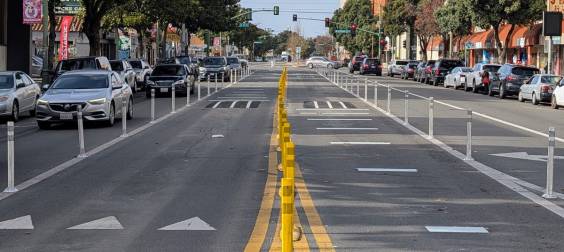As we prepare to bid goodbye to 2020, Streetsblog SF continues its interview series with local and national experts to lay the groundwork for the best possible transit mega-measure for the 2022 (or 2024?) November election. Last month Streetsblog spoke with Adina Levin, with Friends of Caltrain, about lessons learned from recent ballot measures, including RR, which passed in November 2020 to support the expansion of Caltrain.
This month, Streetsblog spoke with Ian Griffiths of Seamless Bay Area. Griffiths echoes Levin’s call for a transit agency, most likely MTC, to step forward and lead a public process to craft a new measure that brings all stakeholders to the table. Griffiths, like many in the Bay Area, believes that a firm plan on how to integrate all transit agencies' fare structures is necessary for a mega-measure to pass.
To see all of the interviews in this series, click here.
(Note: the interview was lightly edited for clarity.)
Streetsblog (SB): You mentioned that this opportunity to build and pass a regional measure is one that has to be big, has to be transformative, or else it is a missed opportunity.
Ian Griffiths (IG): Looking historically at the Bay Area over the past five decades, when we have the opportunity to create large changes...these opportunities haven’t come along that often. For transportation in particular, it’s been a long time since we’ve done anything truly transformational.
I’d say the last time was the creation of BART.
So, the next six months are important and will decide how ambitious and how clear-headed we are about identifying how our equity and affordability and our climate goals should support and underlie our transportation system and what reforms are needed to create that reality.
That is going to greatly shape what a regional funding measure looks like. And ultimately, that will have a significant impact on people’s decision to vote on such a measure.
We need a ⅔ majority to pass a measure, across nine counties. To achieve that, there has to be a sense that we are doing something different than what we’ve done in the past because our past regional measures, and to be frank many of our past local measures, the results have been mixed at best in terms of leading to increased access, increased ridership and reduced Greenhouse Gas Emissions.
SB: We’ve discussed the Fare Integration Task Force; I know this is a project you’ve worked closely with. Could you describe what it is, where you are in the process and how it plays into a future regional ballot measure?
IG: Sure.
The MTC was upgrading Clipper to a new generation system. When customers were asked what they wanted to see changed a couple of years back, the number one suggestion was more consistency between the transit systems. There was no easy way to transfer. There was no consistency in what was actually paid.
SPUR and Transform and Urban Habitat and a number of other groups had long advocated for more equitable fares. At the start of this year, MTC approved and started on, prior to COVID, a study called the “fare integration coordination study.” The study was funded by RM2 money, passed in 2004.
It’s been that long since we have earmarked money for fare coordination and we’ve only gotten around to doing it now.
Since the beginning of this year, the heads of most of the transit agencies have been meeting as part of this task force to oversee a business case for integrated fares, looking at the different options, and analyzing the different benefits for ridership, equity and climate... as well as the costs.
We don’t always do this with transportation projects. We do an EIR, but that’s only looking at environmental impacts. We don’t always look at broad social benefits and costs before making a strategic decision to invest in something.
That’s a process that’s underway and we expect that it will carry into late 2021.
The hope, among advocates at least, is that this will really identify the importance that integrated fares can have on motivating people to ride on transit and expanding equitable access to really cut through the agency-by-agency resistance that’s often existed.
This fare integration study is currently considering options that would require governance reform. It could require an agency that doesn’t exist right now. Or an existing agency adding a new function to do something it doesn’t do right now. We feel very strongly that these options for fare integration that can’t be delivered right now because of our fragmented institutions need to be studied.
We shouldn’t take anything off the table just because right now they may not be achievable. We need to build a case for government reforms and legislation and funding that will be needed to implement these visions.
SB: Is there a role for a mega-measure on the ballot in 2021 or after to move the ball forward to an integrated fare system?
IG: Absolutely.
We know that integrating fares will cost money, and that’s been one of the main barriers in the past...that there hasn’t been a source of funding ear-marked to make the transit agencies involved whole. They currently worry that they will lose out in funding. Having a regional measure that also funds integration would be extremely helpful in seeing that happen.
The good news is that both of the regional proposals that were on the table last spring, Voices for Public Transportation and Faster Bay Area, identified funding for fare integration.
So it’s important that we commit to fare integration now, while we’re still in the study phase, so that we’re clear about what we want to achieve. There very likely could be money for it, and we should know how we’re going to deploy that money.
SB: I’ve heard almost nobody, well nobody that isn’t an executive at a transit agency, say anything bad about fare integration. But that’s just anecdotal, do you have any firm polling numbers on fare integration?
IG: I do, right in front of me actually.
SB: How about that?
IG: As part of Plan Bay Area, they did polling. Of the dozens of strategies they looked at, the most popular was “a requirement that Bay Area public bus and train agencies coordinate schedules, fare structures and payment systems throughout the Bay Area.”
It had 88% support among the public. 54% strongly support. 34% somewhat support. Only 8% opposed to that.
So it’s hugely popular among the public. Not just fare integration, but a more broad integration.
I personally believe it’s going to be hard for us to pass a regional measure without giving the public some confidence that we’re building a seamless system. There’s other polling that’s been done, done by the Faster Coalition last year, that showed significant support for a regional measure, close to the ⅔ threshold. But it was particularly high when it was associated with the words “seamless,” “affordable,” "integrated"... those were the promises that the public wanted to get for supporting the measure.
But it also found skepticism about our agencies’ ability to deliver on those promises.
SB: As we’re looking at things, we’re in mid-December 2020, is there anything happening now with the groups involved with Faster or Voices for Public Transportation to lay the ground work or write proposals? Or is this a next-year push? Sorry, you’re the last interview of the year for me, so you get that question.
IG: So, here’s the thing. Back when CARES Act funding came through, and inter-agency Blue Ribbon Task Force was set up to coordinate the different agencies and their recovery strategies, but also to help insure that agencies have a long-term plan to best use agencies’ joint resources into the future.
At their last meeting, the Voices for Public Transportation Group (including myself) made a case that we need a public convener, a public agency, that really sets the table for a discussion of a regional measure. That needs to start very soon.
That is what we see when we look at regions that have passed these measures in the past. They’re led by the public sector. They’re led by a non-partisan, trusted agency that can bring together the different voices from various parts of labor, advocates, and business. The sooner that gets started, the better.
The longer we don’t have a public process, the harder it’s going to be to bring the different groups together.
We are encouraging MTC to start that process in 2021, and present a timeline and commit to a public process and ensure that there’s something we can all be working together on. Transit advocates, equity advocates, riders, labor, business leaders... we can all be working together from the beginning this time.
So that’s another reason the next six months are important, MTC can decide they want to step up and lead and create a multi-stakeholder process. That doesn’t mean we’re going to be ready to head to the legislature in 2021, or even 2022. It’s going to take time for that kind of process to play out and come up with a shared vision.
So we want to see that started as soon as possible.
MTC is the only regional transit agency that we have, as flawed as it is. But they are the best chance we have to have an agency step into the leadership role and set a table where everyone feels their voices can be heard.
We all want better transit at the end of the day.






